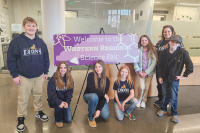The science and art of cadaver dog training
“A dog is an amazing thing,” says Orval Banks, smiling wryly and adjusting his faded gray ballcap.
He’s explaining the techniques he uses to train dogs, but really, he says, you don’t train a dog. It knows what it’s doing, and you’re just teaching it to communicate with you and teaching yourself to understand its subtle language. Because, you see, a dog is an amazing thing.
Banks runs a company called Southern Pride Search and Rescue Dogs, so he knows something about dogs.
He’s a wizened character, in plaid shirt and jeans, whose name often gets mistaken for Wilbur. He’s not sure why. He’s pretty soft-spoken but knows more than most in his field about what makes a good search dog.
“Train, train, train,” says Banks, chuckling slightly.
And he’s been training dogs now for more than 20 years. His dogs are cross-trained, both in search and rescue and what law enforcement refer to as search and recovery, when they’re looking for remains instead of people.
Rescue, though, says Banks, is his first job.
“I like to get them trained on finding the live people first because that’s a priority. Dead people are not going anywhere,” says Banks.
Still, though, recovery of remains are accounting for more and more of his calls these days, around 50 percent.
Banks isn’t a Haywood County native — he was born in Yancey County and moved around in his younger days — but he’s lived here now for 35 years, and it was 40 years ago that he got into search and rescue, mostly as a volunteer.
A few weeks ago, Banks helped out at a training day for cadaver dogs and their handlers held at Western Carolina University, though he’s loathe to use the word ‘cadaver,’ favoring the less abrasive ‘human remains detection.’
Unlike a lot of that crowd, and the cadaver dog world generally, he’s not from a law enforcement background. He keeps at it four decades later for the love of finding that which was lost.
“If you ever find a little four-year-old kid that’s been out there a couple of days and it’s getting dark, and the temperatures are about freezing, it makes it all worthwhile, you get kind of hooked on it,” says Banks.
And he’s good at it, too, which he puts down to the intensive amount of training that he does with his dog, about twice a week.
“There’s a lot of people that don’t train but once every two or three months and then wonder why they never find anybody,” says Banks. “Every time you go out with your dog, you learn something about your dog.”
The training at WCU was held at the school’s Human Identification Lab.
They used to call it the body farm, but now they stick to FOREST, which stands for Forensic Osteology Research Station. Basically, it’s a place for scientists to study how the human body deteriorates under certain conditions. And it’s only the second of its kind in the country, so when it offers a workshop for cadaver dogs, it’s a pretty popular draw.
They had to turn away 27 handlers who wanted to bring their dogs.
“They get the opportunity that they don’t ever get anywhere else, of letting their dogs see a full cadaver,” says Banks. “It’s good to expose the dog to that, to put everything in perspective to the dog, [to say], ‘OK, this is what you’ve been looking for the whole time.’”
And, says Paul Martin, who helped run the workshop, the scent of real people is different than what you can train on elsewhere.
“You have the ability to work with scents you’d never have the ability to do,” says Martin. He, unlike Banks, comes from a law enforcement background, but agrees with him that much of training is about learning the dog, and letting the dog learn the handler.
“Part of it is identifying the animal behavior patterns,” says Martin.
Banks agrees.
“The biggest problem is that a lot of handlers don’t train enough to be able to read their dogs. You’re teaching a dog and teaching yourself to communicate with each other. The dog knows what he’s doing. A lot of people think they’re teaching a dog to smell something dead,” said Banks, but they’re really learning to notice when the dog does.
According to Martin, things have changed in the field over the last ten years. Human remains detection, or HRD, is becoming more in-demand.
“The specialty has evolved over the last 10 to 15 years,” says Martin. “It’s such a complex field. We’re asked to find the one drop of blood, to find the remains that have been buried for 10 years, to find the remains that have been scavenged.”
And, like Banks said, half his work now is in HRD, because, he says, it’s just a lot harder to get lost these days.
“About 12, 15 years ago, we were at the peak, we were doing about 100 [search and rescue] callouts a year,” says Banks. “But people are starting to get GPS units, cell phones, and there’s getting to be so many people in the woods, you have to work at getting lost anymore.”
There are those now, he says, who are getting in to the field for the wrong reasons — for the prestige, for a certificate that they feel somehow validates their dog for breeding — but many, like himself, are in it to help.
And after 40 years of searching and 20 years with a dog by his side, he doesn’t think that’ll change anytime soon.





